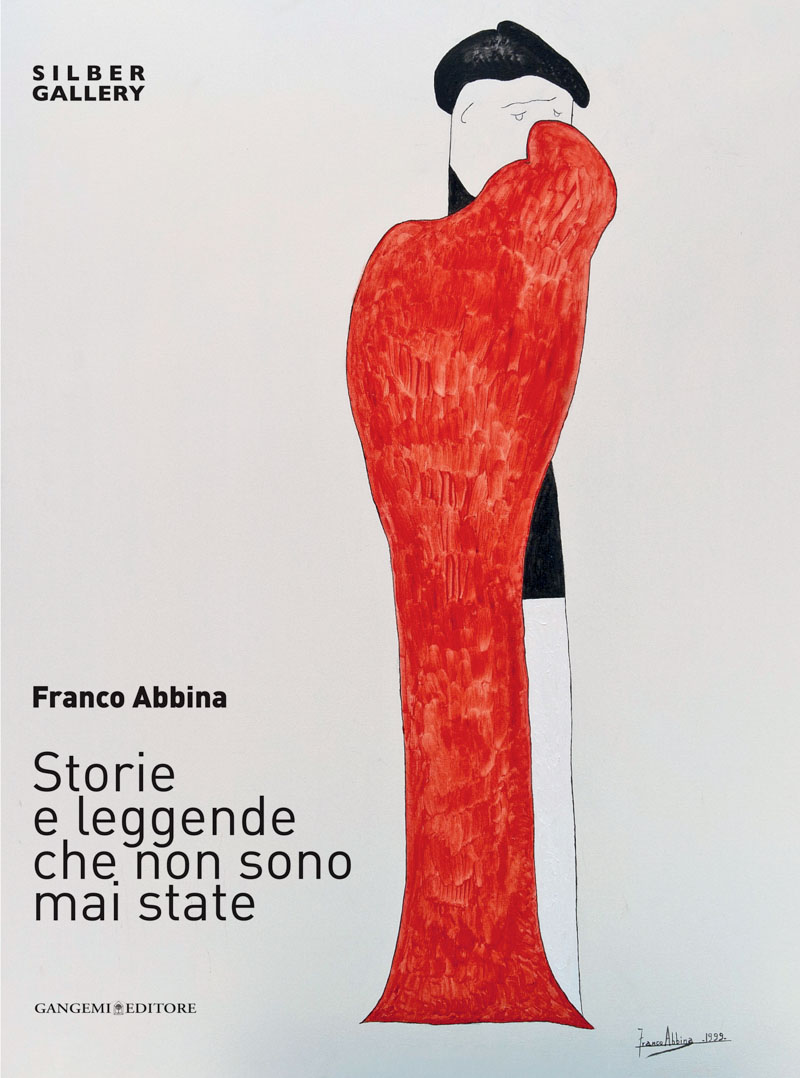
Fuori commercio
Storie e leggende che non sono mai state
Autori: Abbina Franco
Facing English text
Formato: 24,5 x 33 cm
Legatura:
Pagine:
Anno edizione: 2013
ISBN:
EAN: GE6018
UB. INT. : T237C
Contenuto
Per acquistare il libro clicca qui
Un libro singolare, questo di Franco Abbina, Storie e leggende che non sono mai state, un libro che “può essere per il lettore un talismano di saggezza felice”, come suggerisce la nota editoriale d’apertura. Tenero e graffiante, amabile e irriverente: poetico, nel senso più alto del termine, ossia creativo, badando a leggere negli interstizi tra una storia e l’altra, e poi nell’ordito complessivo dell’arazzo, il senso di una vita che attraverso la scrittura “pesca sogni” e dipana il filo di ricordi e desideri guardando il cielo, come fa il personaggio François degli ultimi racconti (una sorta di eteronimo dell’autore, evidentemente), “attraverso pezzetti di vetro colorato”.
Diviso in due (anzi in tre) parti, tra una prima, eponima, che dà il titolo all’insieme, e la seconda, la più estesa, dedicata, come da intestazione (“Certa gente così”), alla rappresentazione di tipi umani molteplici e diversi, il tutto accompagnato da una nutrita carrellata di “immagini”: si presta a molte letture, o meglio predispone con accorta regia autoriale angolature differenti, almeno quante sono le parti che lo strutturano.
Non dunque soltanto un’”ironica riflessione sui difetti umani”, come lo aveva a suo tempo già definito la poetessa Alda Merini, senza fare distinzioni tra aspetto contenutistico e iconico del testo, concentrata com’era soprattutto sulla caricaturalità di figure e personaggi che in esso è dato di incontrare. Oggi, si può dire anche qualcosa di più, prendendo in considerazione entrambi gli aspetti: si può dire per esempio che si rivela dotato multis luminibus oltre che ingenii, anche multae tamen artis. Che cioè occorre guardarne sia ciò che dice nello specifico dei testi, delle “storie e leggende”, sia ciò che “comunica” attraverso le immagini che di volta in volta s’incistano e incrostano nel testo stesso, ma anche perfino ciò che non dice (o non vuole dire).
Per esempio, mi colpisce una cosa, a scorrere le pagine del libro di cui l’autore ha voluto farmi omaggio, il fatto cioè che almeno tre tra i testi originari del libro sono stati cancellati (“Alla ricerca di una identità”, “Amore di quartiere” e “La vittima”), per il primo dei quali si suggerisce senza mezzi termini il sostituto, ossia un testo dal titolo emblematico “Coerenza sentimentale”. Una ricerca di “identità”, insomma, che si svolge paradossalmente sul filo della trasgressione: come dire che l’esistenza (ex-sistere, essere cioè “attimo dopo attimo”) si inventa i propri spazi di libertà al di fuori di ogni legge, di ogni forma data.
Ma chi è l’autore? Franco (François?) Abbina è molte cose insieme, un vecchio giramondo della cultura, dall’aria piratesca alla Moustaki: attore teatrale e cinematografico, cultore di musica, pittore e scrittore, ma anche imprenditore. Un grande “dilettante”, insomma, nel senso più etimologico del termine: uno cui piace il fare, il mettersi in gioco.
L’opera di cui qui parliamo è un’opera narrativa e visiva al tempo stesso, che ha in una scrittura fulminante ed essenziale il suo pregio più importante.
Un libro composito, del genere che i latini chiamavano satura (lanx), ossia “pietanza ricca e succulenta di cose differenti”, in cui l’abbinamento di intingoli è capace di dar luogo a sapori imprevedibili, ad allettanti manicaretti, non senza una punta di acre, corrosiva irriverenza. Storie e immagini infatti vi si incrociano e contaminano in missaggi sorprendenti, a partire da ciò che il titolo stesso dice, ossia che il récit si svolge lungo il filo di cose “che non sono mai state”.
Questo per dire che vivono e si incontrano, le prime come le seconde, dotate di vita propria e autonoma, salvo reclamare l’urgenza di uno sguardo complessivo, non rapsodico: né commento né didascalie le une delle altre, hanno la forza dell’essere se stesse, proponendosi senza pudore per quel che sono, omaggi fantastici all’esistere, spazi di desiderio, “ricerche di identità” attraverso vite imprestate, immaginate.
Con l’esistenza, la vita quotidiana, fissata, come uno “spettacolo” multicolore regolato da una sapiente regia, in tratti che ricordano di volta in volta la penna acuminata e velenosa di Grosz, l’espressionismo di Viani, il grafismo arcaico e grottesco di Antony de Witt, il tratto un po’ naif di Gino Meloni, senza citare le sorridenti e surrealiste atmosfere di alcuni disegni di Garcia Lorca. Il tutto con un surplus, nell’amalgama, di un incantevole sapore.
VINCENZO GUARRACINO
Aremarkable book, this one of Abbina Franco, “Tales and Legends that have never been”; a book that can be a talisman of wisdom for the happiness of the reader, as the editorial opening notes suggest. Tender and sharp, kind and irreverent: poetic in the highest sense of the term; namely attractive, paying attention to the reading of the interstices between one story and another, as well as to the understanding weft of the tapestry; the sense of a life that “fishes dreams” through writing and unravels memories and desires by looking at the sky, as does the character of the last stories, François (a sort of heteronym of the author, evidently), through small pieces of tinted glass.
The book is divided into two (no, three) parts: the first one, eponymous, which gives the title to the whole, and the second one, the vastest one, dedicated to representation of multiple and diverse types of human beings, as the title let us know (“Certain people so”). A whole accompanied of a well-stocked carousel of “images” is subject to different readings, or better said, it predisposes us to different angles by the clever organization of the author, at least as much as the structural parts are diverse in angles.
It is therefore not just an “ironic reflection on human defects”, as poetess Alda Merini had already defined previously, where she did not distinguish between contents and icons of the text and mainly focused on the preposterous aspect of figures and characters within it. Today it can be added the following: considering both contents and icons, it can be said, for example, that it reveals itself blessed with multis lumonibus as well as ingenii, and also multae tamen artis; that this happens by looking both at what is specifically said in the texts, “tales and legends”, and what is communicated through the images from time to time, enclosed and embedded in the text itself; but also even looking at what is not said (or does not want to say).
For example, when turning over the pages of the book, which the author has bestowed upon me, I am impressed with the fact that at least three texts amongst the original book have been removed (“Looking for an identity”, “Neighbourhood love” and “The victim”). For the first one a replacement suggests itself immediately; a text with an emblematic title “Sentimental coherence”; a search for an identity which paradoxically develops on the sharp edge of transgression: as to say that existence (ex-istence, namely to be instant by instant) creates its own spaces of freedom outside any law or given form.
But, who is the author? Franco (¿François?) Abbina is a lot of things together, an old globetrotter of the culture with a Moustaki style pirate resemblance: theatre and cinema actor, a cultivator of music, painter and writer, or even an entrepreneur.
A grand “amateur” in the most etymological sense of the term; one who enjoys doing, testing himself.
The work we are talking about is narrative and visual at the same time, which has a fulminant and essential writing, and this is its most important merit.
A heterogeneous book with a satura (lanx) style, term used by the Latin; namely, “rich and succulent food” whereby the mix of gravies and stews brings us unpredictable flavours and attractive delicatessens, although not without a pinch of sourness, corrosive irreverence. Stories and images which in fact cross and contaminate each other within surprising mixtures from what the title itself says; that is to say that the récit develops along the thread of things “that have never been”.
This is to say that they live and meet, first and second part, blessed with their own and selfgoverning lives, except from claiming the urgency of a global, non-rhapsodic look: no comments or lecturing from one another; they have the strength of being themselves, offering themselves without feeling ashamed for what they are; fantastic tributes by their existence; spaces of desire; “identity search” through borrowed lives, imagined lives. With existence, daily life, perpetuated, like a multicolour spectacle structured by a wise guide made through his strokes, which reminds us once again of the sharp and poisonous penmanship of Grozs, the expressionism of Viani, the archaic and grotesque handwriting of Antony Witt and the slightly naïve stroke of Gino Meloni (let us not forget the happy and surrealistic atmospheres of some of Garcia Lorca’s drawings).
All of that with a surplus of an enchanting flavour within the amalgam.
VINCENZO GUARRACINO
Parole chiave
Condividi su
